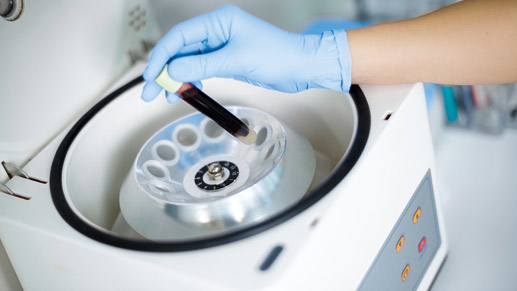Centrifuges Repaired, Serviced & Calibrated
Call us for Immediate Support - 0845 6021918 eMail - support@uklabservices.co.uk

UK Laboratory Services maintain repair, carry out preventative maintenance service contract visits and IQ, OQ, PQ verification of most types of centrifuges.
What is a Centrifuge?
A centrifuge is a device for separating particles from a solution according to their size, shape, density, viscosity of the medium and rotor speed. In a solution, particles whose density is higher than that of the solvent sink (sediment), and particles that are lighter than it float to the top. The greater the difference in density, the faster they move. If there is no difference in density (isopycnic conditions), the particles stay steady. To take advantage of even tiny differences in density to separate various particles in a solution, gravity can be replaced with the much more powerful “centrifugal force” provided by a centrifuge. This technique plays crucial role in biochemistry or biotechnology as it is non-dispensable part of one or the other step in every method involved in biological study right from the separation of cell organelles to complex experiments involving separation of sub-cellular fractions. Types of Centrifuges and their Uses: There are four major types of centrifuges. They are: Small Bench Centrifuges: They are used to collect small amount of material that rapidly sediment like yeast cells, erythrocytes etc. They have maximum relative centrifugal field of 3000-7000 g. Large Capacity Refrigerated Centrifuges: They have refrigerated rotor chamber and have capacity to change rotor chambers for varying size. They can go up to maximum of 6500 g and use to sediment or collect the substances that sediment rapidly like erythrocytes, yeast cell, nuclei and chloroplast. High Speed Refrigerated Centrifuges: They can generate speed of about 60000g and are used to collect micro-organism, cellular debris, larger cellular organelles and proteins precipitated by ammonium sulphate. Ultra Centrifuges: (a) Preparative ultracentrifuge: It can produce relative centrifugal force of about 600000g and its chamber is refrigerated, sealed and evacuated. It is employed for separation of macromolecules/ligand binding kinetic studies, separation of various lipoprotein fractions from plasma and deprotonisation of physiological fluids for amino acid ananlysis. (b) Analytical ultracentrifuge: It is capable of operating at 500000 g.
Three kinds of optical systems are available in analytical ultracentrifuges: a light absorption system, and the alternative Schlieren system and Rayleigh interferometric system, both of which detect changes in the refractive index of the solution. Design and Types of Rotors: Swinging Bucket Rotors: The swinging bucket rotor has buckets that start off in a vertical position but during acceleration of the rotor swing out to a horizontal position so that during centrifugation the tube and hence the solution in the tube, is aligned perpendicular to the axis of rotation and parallel to the applied centrifugal field, the tube returning to its original position during deceleration of the rotor. Fixed Angle Rotors: In fixed angles the tubes are located in holes in the rotor body set at a fixed angle between 14° and 40° to the vertical. Under the influence of centrifugal field, particles move radially outward and have only a short distance to travel before colliding with, and precipitating on, the outer wall of the centrifuge tube. A region of high concentration is formed that has a density greater than surrounding medium, with the result that the precipitate sinks and collects as a small compact pellet at the outermost point of the tube. Vertical Tube Rotors: They are considered as zero angle fixed angle rotors in which the tubes are aligned vertically in the body of the rotors at all times. Zonal Rotors: The zonal rotors may be of the batch or continuous flow type. The former being more extensively used than the latter, and are designed to minimize the wall effect that is encountered in swinging- bucket and fixed angle rotors, and to increase sample size. Elutriator Rotors: The elutriator is a kind of continuous flow rotor that contains recesses to hold a single conical shaped separation chamber, the apex of which points away from the axis of rotation, and a bypass chamber on the opposite side of the rotor that serves as a counter balance and to provide the fluid outlet. Care of Rotors: The protective anodized coating on aluminium rotor is very thin and does not provide a high degree of protection against corrosion; thus rotors should always be handled with care to prevent scratching. Rotors should always be thoroughly washed preferably with de-ionised water and since moisture is a potential source of corrosion, they should be allowed to dry upside down in a warm atmosphere; they should then be stored in a clean, dry environment. Rotors’ outer surface only can be given a protective coat of lanolin or silicone polish. Swinging-bucket rotors, however, should never be completely immersed in water as the bucket hanging system is difficult to dry. Titanium rotors are essentially resistant to corrosion. To prevent possible damage to the drive shaft of the centrifuge due to vibration caused by rotor imbalance, sample loads should be balanced within the limits specified by the manufacturer. Swinging-bucket rotors should not be run with any bucket or caps removed or individual rotor buckets interchanged as they form integral part of the balance of the rotor. During acceleration and deceleration of the rotor, cyclic stretching and relaxing of metal can cause metal fatigue, leading to eventual failure of rotor. To avoid overstressing the rotor and to ensure its continued safe operation, an accurate record should be kept of its total usage, i.e, number of runs (at any speed) and time of each run so that rotor can either be de-rated after a certain number of runs or replaced after a set period of time as specified by manufacturer. Sample Containers: Centrifuge tubes and bottles are available in different range of sizes, thickness and rigidity from different variety of materials including glass, cellulose, esters, polyallomer, polycarbonate, polyethylene, polypropylene, kynar, nylon and stainless steel. The type of container used will depend upon nature and volume of sample to be centrifuged along with centrifugal forces to be withstood. Glass centrifuge tubes are suitable only for centrifugation at low speeds as they disintegrate at higher centrifugal fields. Thin walled tubes may be used in swinging bucket rotors because the tube is protected by the surrounding bucket; however, thick walled tubes are required with fixed angle and vertical tube rotors. The centrifuge tubes should be filled to accurate level and need to cap the tube or bottle depends upon the speed and type of the container used. Major precautionary measures in selection of a tube (plastic) material: Precautionary Measures with Centrifuges: Centrifuges are extremely dangerous instruments if not properly maintained and correctly used. It is, therefore, always advisable that one must read and understand the operating manual for particular centrifuge. Manufacturers of centrifuges should ensure effective lid locks. Access to the rotor chamber of centrifuges should always be avoided when spin is in progress. Centrifuges should have imbalance detectors, over speed detectors and devices and ability to contain any failure of rotor. To prevent possible physical injury when rotors are filled and emptied, care must be taken to ensure that the moving rotor is not touched and that long hair and loose clothing (e.g., Ties) do not get caught in any rotating part. This is especially important with older centrifuges where lid can be opened before the rotor has stopped rotating. It is important when is centrifuging hazardous materials like pathogenic microorganisms, infectious viruses, carcinogenic, corrosive or toxic chemicals, radioactive materials), especially in low speed non-refrigerated centrifuges in which rotor temperature is controlled by air-flow through the rotor bowl , samples should be kept in air-tight, leak-proof containers. This is to prevent aerosol formations arising from accidental spillage of sample which would contaminate the rotor, centrifuge and possibly the whole laboratory. Discovery, Evolution, RC3, RC4, RC3b, RC5, RC5b, RC6, RC12, RC24, RC28, Biofuge 13, 13r,15r, 28, 28e, Biofuge fresco, Biofuge Pico, Biofuge Primo, Discovery, RT7, RT17, RT6000, Acuspin, Cryofuge, Labofuge, Legend, Megafuge, Cellsep, Centaur, Calypso, MSE, Falcon, Harrier, Cyclon are some of the models we cover.
All major manufacturers covered including:
MSE | Binder | Techne | LTE |
Sanyo Gallenkamp | Thermo | Grant | Medline |
Heracell | Fisher Scientific | Infors | Memmert |
Bibby Sterilin | New Brunswick | LMS | Eppendorf |

Thermo fisher Heraeus biofuge stratos centrifuge & Sorvall Legend refrigerated centrifuge repair. Got our Thermo fisher Heraeus biofuge stratus centrifuge & Sorvall Legend refrigerated centrifuge repaired calibrated and serviced by UK Laboratory Services of Oxfordshire. Our bank of centrifuge models a spread out between our Kent, Cambridgeshire, London and Oxfordshire laboratories. Our Thermo fisher Sorvall legend refrigerated models are at our Kent and London labs and thermo fisher heraeus biofuge stratos centrifuge at our Cambridge and Oxfordshire labs but this was not a problem to have them all covered on the one service contract with this company. Great service. Thermo fisher could not match the contract price for the Sorvall legend or heraeus biofuge stratos servicing.
